U-Turn of Industrial Policy Erodes the Very Base of Agriculture
By Abhijit Guha, translated by Debarshi Das (Sanhati)
“Destination West Bengal”: this is the rather pompous sounding slogan which the Left Front government of West Bengal has used since it made a U-turn in the 1990s, and started on a reverse course from its earlier incomplete task of land reform. To investigate the possibilities of industrialisation the state government all of a sudden appointed McKinsey, a multinational consultancy group. The booklet titled “Destination West Bengal” is in fact based on McKinsey report. Curiously, this is the Left Front government, taking out processions, organising meetings protesting entry of multinational corporations all the time – which called in McKinsey. Could not the faculty members of Indian Statistical Institute or Indian Institute of Management, Kolkata, who are renowned internationally, perform the same job that was handed over to McKinsey?
If one browses through the book one finds that in the last twenty years there has been wonderful political stability in the state and that the state government in its 1994 industrial policy has welcomed the privately owned industries. Some of the achievements of state government have been described eloquently in the first part of the booklet. In the last five years the growth rate of West Bengal has been satisfactory. High agricultural growth has been the primary reason for this. It has been pointed out that during 1995-96 the growth rate of West Bengal has been higher than the national average. In agriculture, especially in foodgrain production, the success is said to be remarkable. During the period 1982-83 to 1992-93 food grain production growth rate in West Bengal has been the highest among Indian states. As a consequence, there has been substantial rise in the purchasing power of the people of the state. The rest of the booklet “Destination: West Bengal” discusses, in a rather attractive manner, how industrialisation will proceed in a number of areas of the state. These areas are, Siliguri, Dankuni, Salt Lake, Kalyani, Asansole, Durgapur, Kharagpur, Bantala, Haldia, Falta etc. In the final section of the book (“Look, Who All are There”) we find names of a host of Japanese multinational firms. They will invest in West Bengal. After that, spanning three pages there is a list of big multinational corporations from USA, Switzerland, the Netherlands, Australia, Austria, South Korea, UK which have invested in West Bengal. Is the whole world inside the briefcase of WBIDC, or is the entire Bengal within the suitcase of foreign capitalists?
The so called backward regions of Medinipur which were selected for industrialisation (due to the industrial policy) are Haldia and Kharagpur rural regions in the East Medinipur and West Medinipur districts respectively. Large tracts of agricultural lands were acquired for industrialisation purposes in these two areas. During 1991 – 1997 much more land were acquired in these regions compared to what is being grabbed at Singur. However, apart from a few local agitations and reports or writings on local newspapers, not much had happened.
Let us have a look at the land acquisition of the undivided Medinipur district. 14,319.40 acres of land were taken in the undivided Medinipur during 1991 to 1997 – for various reason, chiefly for industries. Immediately after the central government announced its policy of liberalisation, the Left Front government of West Bengal started acquiring vast tracts of land for industrialisation, in a district which is almost completely dependent on agriculture. Data tell us that the concern of the Left government for improvement of agriculture or adequate irrigation facilities or rehabilitation for the displaced was becoming less and less noticeable in the era of liberalisation.
The government started acquiring land on a massive scale for urbanisation, industries, tourism. Village based decentralised development, land reform, rural planning by the villagers were at the receiving end. Haldia Port and Haldia industrialisation, Kolaghat thermoelectric plant and much later pig iron industries in Kharagpur: these issues were raised at the state assembly. An informative and well-organised report on land acquisition of the undivided Medinipur district was prepared by the district administration in 1993. It never got published. What was revealed in this report is truly horrifying. On the contemporary land acquisition in the district it said there have been as many as 293 cases of incomplete land acquisitions. Many of the governmental organisations or the private concerns for which the government had acquired land, were not depositing the money (required to pay the compensation) with the government. Despite repeated notices sent by the land acquisition department, there has been complete silence from their side. Farmers who had lost land were left with no compensation. In case of delays in paying compensation to the government, the concerned organisation is required to pay interest at the rate of 9% per annum for the first year and 15% per annum from the next year onwards. This sum alone adds up to Rs. 260 millions. The government irrigation department is the highest defaulter, the amount is Rs, 14,54,20,607. The public works department comes second in the list. It had got lands acquired for building roads – but no road has come up. It has a pending sum of Rs. 8,19,81,577. After this we have South-eastern Railways, Agricultural Marketing, Agriculture, Public Health and Technology departments. The report also mentions that those organisations which did not pay have already constructed buildings on the land, or have built fragments of a road or have dug an irrigation canal. If these lands are to be returned to their previous owners they will be not in their formal state. Courtesy government propaganda, land acquisition for development may seem to be a quick administrative process. The inside story is pretty terrible.
The new industrial policy of the state government harms the base of agriculture of the state. The main line of the new industrial policy is: due to land reform and growth in agriculture there has been rise in the purchasing power of the rural population. Therefore West Bengal is now a fit case for industrialisation, particularly for heavy and medium scale industries. The Left Front theoreticians have framed the new industrial policy based on this single rationale. The chief minister never gets tired of repeating this. They are forgetting that the land reform has remained incomplete. Taking back land from the pattadars (peasants who have got ownership rights of the redistributed land) and bargadars (tenants who have received proper tenancy rights) will be suicidal. This may result in the economic betterment of a small section of people, but it will also mean rising economic and social inequality. CPI(M), the main political party of the Left Front, and the small allies – CPI, RSP, Forward Bloc, who are after the ministerial berths – have chosen this suicidal course.
The state government had released the West Bengal Human Development Report in 2004. It was edited by Prof. Jayati Ghosh of Jawaharlal Nehru University. The report ends with a chapter which lists 25 suggestions on the future path that West Bengal may follow. It may be noted, in none of these 25 suggestions has it been adviced that since the state of the peasants of West Bengal has improved significantly due to land reform, its future strategy should be that of heavy and medium scale industrialisation. On the contrary, it expresses deep concern that in the recent years bargadars and pattadars are losing their land. The report, which incidentally has got messages from the chief minister and the industry minister printed on it, says in its 9th suggestion, “The government should encourage agricultural and non-agricultural based productive activities in the rural areas and in this connection government may consider forming new cooperatives.” (page 214 - 215) The model of development which the political parties of the Left Front government want to present to the people completely contradicts the research-based data and suggestions of reports of the experts committee appointed by the same government. Our humble request to those who are shouting “Agriculture is our base, industry is our future” is: please read the reports of the government of West Bengal. And think. Hollow shouting does not do any good. History has not forgiven anyone.
The author is Reader, Anthropology Department, Vidyasagar University.
सीपीएम की क्रांति
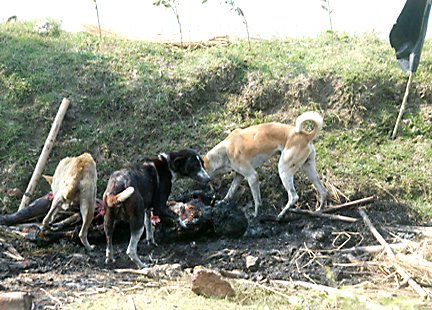
हम एक लोकतंत्र में रह रहे हैं! 14 मार्च को हुई घटना और उसके बाद सीपीएम के बंद के दौरान गायब हुए दो सौ लोगों का अब तक कोई अता-पता नहीं है्. हां। कुछ लाशें हैं जो इलाके में इस हालत में पायी गयी हैं. क्या हम बता सकते हैं कि इन्होंने किस बात की कीमत चुकायी? क्या हम इसको लेकर आश्वस्त रह सकते हं कि हमें भी कभी ऐसी ही कीमत नहीं चुकानी पड़ेगी?
Wednesday, April 25, 2007
Subscribe to:
Post Comments (Atom)
नंदीग्राम पर नयी फ़िल्म
यह फ़िल्म 14 मार्च की घटनाओं के सूक्ष्म विवरण के साथ आयी है.
देखें : नव उदारवाद का नया चेहरा बजरिये नंदीग्राम
देखें : विकास के नाम पर लोगों के उजड़ने की कहानी
उन्होंने मेरे पिता को टुकडों में काट डाला
देखें : न हन्यते
नंदीग्राम में 100 से ज्यादा लोग मारे गये हैं, 200 अब भी लापता हैं. वहां महिलाओं के साथ सीपीएम के कैडरों ने बलात्कार किया. बच्चों तक को नहीं छोड़ा गया है. सीपीएम की इस क्रूरता और निर्लज्जता का विरोध होना चाहिए. हमें नंदीग्राम, सिंगूर और हर उस जगह के किसानों के आंदोलन का समर्थन करना चाहिए, जो अपनी जमीन बचाने के लिए लड़ाई लड़ रहे हैं. यह दस्तावेज़ी फ़िल्म किसानों के इसी संघर्ष के बारे में है. यह फ़िल्म नंदीग्राम के ताज़ा नरसंहार से पहले बनायी गयी थी.
नंदीग्राम में जनसंहार के बाद के द्श्य
यह फिल्म पुलिस द्वारा नंदीग्राम में बर्बर तरीके से की गयी हत्याओं एवं उनकी भयावहता व बर्बरता के बारे में है. इसके कई दृ़श्य विचलित कर देनेवाले हैं.
नंदीग्राम प्रतिरोध्
नंदीग्राम में सरकारी आतंक
देखें : माकपा की गुंडागर्दी
नंदीग्राम में सीपीएम सरकार की पुलिस ने जो बर्बर कार्रवाई की, वह अब खुल कर सामने आने लगी है. यह फ़िल्म उसी बर्बरता के बारे में है. इसके कई दृश्य आपको विचलित कर सकते हैं. आप इसे तभी देखें जब आप वीभत्स दृश्य देख सकने की क्षमता रखते हों. हम खुद शर्मिंदा हैं कि हमें ऐसे दृश्य आपको दिखाने पड़ रहे हैं, पर ये आज की हकीकत हैं. इनसे कैसे मुंह मोडा़ जा सकता है?

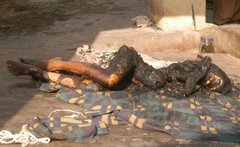
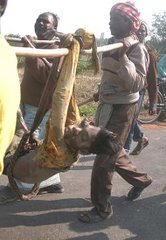
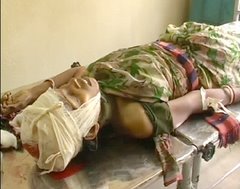

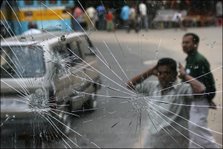
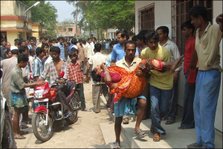

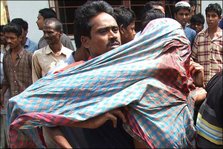


No comments:
Post a Comment